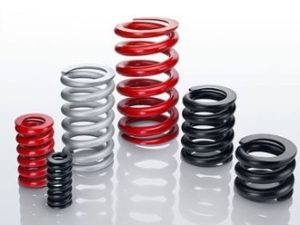 If you’re looking to use compression springs for a specific application, you should know more about them in order to be properly informed of your options before getting them manufactured. Compression springs are one of the most energy efficient storage devices available on the market today—which is why they are the most commonly used metal spring configuration. Generally, they’re used over a rod or they are fitted within a hole.
If you’re looking to use compression springs for a specific application, you should know more about them in order to be properly informed of your options before getting them manufactured. Compression springs are one of the most energy efficient storage devices available on the market today—which is why they are the most commonly used metal spring configuration. Generally, they’re used over a rod or they are fitted within a hole.
Applications Are Almost Infinite
From mattresses, lawnmowers, major appliances, and vehicles to pens, medical devices, cell phones, and electronics, compression springs are used in a wide variety of applications. They are integral in the performance of many products in just about every industry. For many products, like pens and valves, they are the most inexpensive and reliable solution.
How They Work
These open-coil helical springs offer resistance through compression. Once they are compressed along the axis of wind, the linear force they exert increases the further they are compressed. They push back against the load being applied to them while trying to get back to their original length. They are different from other types of springs because they don’t need attachment points in order to function.
Typical Body Configurations
Their wire size can range widely in diameter and they can be manufactured in many shapes with many different types of ends to fit a wide range of applications. Their shapes can vary from the common cylindrical shape to hourglass (concave), barrel (convex), and conical. The common straight metal coil spring has the same diameter for its entire length.
Ends
The ends you’re going to need for your compression springs vary depending on the application. You have four options to choose from: open ends; closed ends, not ground; open and ground; and closed, squared, and ground. With open ends, the coils are consistent and there is no pitch change. Closed ends, not ground consist of springs that have a reduced pitch at the end coils so they touch. In open and ground ends, the last coil tip is flat. Finally, closed, squared, and ground ends are flat in appearance and have a paralleled end.
Basic Parameters to Understand
To consider the specifications you’re going to need when manufacturing your compression springs, you’ll need to consider the wire diameter, outer diameter, inner diameter, solid height, and free length that you’ll need for your specific application. The free length is described as the spring’s overall length in the unloaded position, while solid height refers to the length of the spring under sufficient load that brings all of its coils into contact.
You’ll also need to know which spring rate, or stiffness, you’re going to need. This is the change in load per unit deflection in Newtons per millimeter or in pounds per inch. These dimensions and the load/deflect requirements will determine the stresses of the compression springs. Getting these stresses calculated properly is vital to the optimal performance of your springs. The design must be calculated based on your specific application in order for your springs to work correctly.
Consult a Professional
There’s a lot to know when you’re on the search to buy compression springs. The best thing you can do for your product is to consult a spring manufacturing expert who can calculate the exact configurations you’ll need and walk you through the different material, shape, end, and size options that will work best for your intended application.
Belt Tensioner Spring
Learn How We Helped an Automative Parts Manufacturer
Reduce Spring Cost by 20%
